
Number 8, March
2011

What's Here for You:
Vibration Isolation News is designed to keep our customers and friends up to date on the latest products and applications designed to facilitate better measurements and improved nanomanufacturing. We are an OEM supplier to leading manufacturers of scanning probe microscopes, micro-hardness testers and other sensitive instruments, and we have users at more than 200 leading universities and private and government laboratories in 35 countries.

INDEX
1. Improving
nanoimaging of µ-Raman/AFM systems
2. Featured
Product: BM-1 Now Handles 1000 lbs
3. Press
Release: Minus K Isolators help look for Dark Matter
4. Minus K is a Veteran Owned California Certified
Small Business
5. Upcoming Nanotechnology
Meetings and Webinars
6. We want to hear from YOU

Minus
K Technology currently builds
vibration
isolators to handle payloads from
3 lbs to 10,000 lbs (per isolator).
When you need the best isolation for your dollar.
Our
patented technology will provide you true 1/2 Hz performance.
Give
us your challenge.

Improving nanoimaging of µ-Raman/AFM systems
By Jim McMahon
Excerpted from Electronic
Products Online - November 2010
The need for
precise vibration isolation with scanning probe microscopy
(SPM) and nearfield scanning optical microscopy (NSOM) systems
is becoming more critical as resolutions continue to bridge
from micro to nano. Whether used in academic labs or commercial
facilities, SPM and NSOM systems are extremely susceptible
to vibrations from the environment.
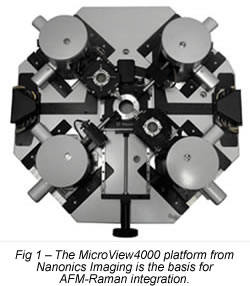 When
measuring displacements of a very few angstroms or
nanometers, an absolutely stable surface must be established
for the instrument. Any vibration coupled into the
instrument's mechanical structure will cause vertical
and/or horizontal noise and thus reduce the system's
ability to measure high resolution features. And while
the vertical axis is the most sensitive for SPMs,
they can also be quite sensitive in the horizontal
axis.
When
measuring displacements of a very few angstroms or
nanometers, an absolutely stable surface must be established
for the instrument. Any vibration coupled into the
instrument's mechanical structure will cause vertical
and/or horizontal noise and thus reduce the system's
ability to measure high resolution features. And while
the vertical axis is the most sensitive for SPMs,
they can also be quite sensitive in the horizontal
axis.
AFM with micro-Raman
Micro-Raman is a spectroscopic NSOM technique used in condensed-matter physics and chemistry to study vibrational, rotational, and other low-frequency modes in a system. It relies on scattering of monochromatic light, usually from a laser in the visible, near-infrared, or near ultraviolet range. The laser light interacts with phonons or other excitations in the system, resulting in the energy of the laser photons being shifted up or down. The shift in energy gives information about the phonon modes in the system.
Scanning
samples in a micro-Raman system, however, suffers
from several problems. As even a very flat sample
is scanned, it is hard to keep the lens-to-sample
distance constant. Thus, as one goes from pixel
to pixel under the lens of a Raman, a mixture of
sample and air is sampled in the voxel (volumetric
picture element) that is illuminated. This causes
artifactual intensity variations in the Raman unrelated
to the chemical composition of the sample.
This is even
more pronounced with rough samples, and standard methods
of auto-focus are simply not accurate enough for a host
of problems being investigated today. Additionally, the
point-spread function, which determines the resolution of
the Raman image, is significantly broader where there are
contributions from the out-of-focus light, and this reduces
resolution.
The AFM, being a very high-resolution type of scanning-probe microscope, has demonstrated resolution of fractions of a nanometer, making it one of the foremost tools for imaging, measuring, and manipulating matter at the nanoscale. The information is gathered by "feeling" the surface with a mechanical probe. Piezoelectric elements that facilitate tiny but accurate and precise movements on electronic command enable the very precise scanning.
The AFM consists of a microscale cantilever with a sharp tip (probe) at its end that is used to scan the specimen surface. The cantilever is typically silicon or silicon nitride with a tip radius of curvature on the order of nanometers. When the tip is brought into proximity of a sample surface, forces between the tip and the sample lead to a deflection of the cantilever. Resultant characteristics, such as mechanical, electrostatic, magnetic, chemical and other forces are then measured by the AFM using, typically, a laser spot reflected from the top surface of the cantilever into an array of photodiodes.
Most systems employing AFM in concert with Raman perform separately, executing either an AFM scan or a Raman scan independently. The recently developed direct integration of Raman spectroscopy with AFM technique, however, has opened the door to significantly improved technique and sample analyses.
Micro-Raman is a microtechnique, but when AFM is added, it becomes a nanotechnique. It allows the AFM structural data to be recorded online and improves the resolution of the Raman information when the nanometric feedback of the system adjusts, with unprecedented precision, the position of each pixel of the sample relative to the lens. Also the small movements of the AFM stage provide oversampling, which is a well-known technique for resolution improvement.
One integrated AFM-Raman system developed by Nanonics Imaging in association with major Raman manufacturers such as Renishaw plc, Horiba JY and others provides simultaneous and, very importantly, on-line data from both modalities (see Fig. 1).
Most systems employing AFM in concert with Raman perform separately, executing either an AFM scan or a Raman scan independently. The recently developed direct integration of Raman spectroscopy with AFM technique, however, has opened the door to significantly improved technique and sample analyses.
Micro-Raman is a microtechnique, but when AFM is added, it becomes a nanotechnique. It allows the AFM structural data to be recorded online and improves the resolution of the Raman information when the nanometric feedback of the system adjusts, with unprecedented precision, the position of each pixel of the sample relative to the lens. Also the small movements of the AFM stage provide oversampling, which is a well-known technique for resolution improvement.
One integrated
AFM-Raman system developed by Nanonics Imaging in association
with major Raman manufacturers such as Renishaw plc, Horiba
JY and others provides simultaneous and, very importantly,
on-line data from both modalities (see Fig. 1).
The full
article can be found at: https://minusk.com/content/in-the-news/ElecPro_1110.htm

Featured Product: BM-1 Now Handles Up To 1000
lbs
Minus K has increased the range on
our largest standard isolator. With minimal re-engineering
we have been able to bring our BM-1 isolators up to 1000
lbs and is proud to introduce our new BM-1 models, the
850BM-1 and 1000BM-1.
After
building a few custom 850 and 900 lb systems for clients,
we saw the need to increase the capacities on our standard
BM-1 line. As the knowledge of our isolator's capibilities
and performance reaches new markets, there is a greater
need for additional payload capacities.
This
vibration isolation platform is extremely easy to use.
It offers our signature 0.5 Hz vertical and horizontal
natural frequency.
These new BM-1 Models are now offered in both of our popular workstations, the WS-4 and MK26.
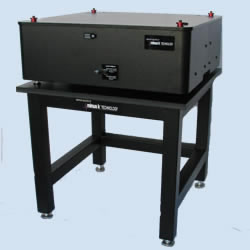
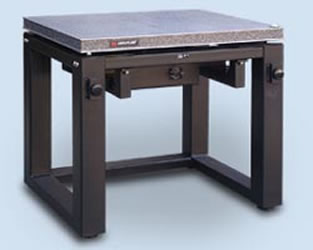
Minus K's BM-1 Pictured on WS-4 Stand MK26 Pictured with BM-1 inside
| Load Capacities (approximate): | ||
| Model | Payload Range* | Price** |
| 100BM-1 | 60 - 100 lb (27 - 48 kg) |
$4,150 |
| 150BM-1 | 90 - 155 lb (41 - 70 kg) |
$4,200 |
| 250BM-1 | 180 - 270 lb (82 - 123 kg) |
$4,515 |
| 350BM-1 | 290 - 370 lb (132 - 168 kg) |
$4,830 |
| 500BM-1 | 360 - 525 lb (164 - 239 kg) | $5,040 |
| 650BM-1 | 500 to 680 lb (227 - 309 kg) | $5,200 |
| 850BM-1 [Weight: Approximately 90 lb. (41 kg)/same dimensions] | 630 to 900 lb (285 - 408 kg) | $6,370 |
| 1000BM-1 [Weight: Approximately 90 lb. (41 kg)/same dimensions] | 890 to 1050 lb (403 - 476 kg) | $6,425 |
| *Contact Minus K for custom payload ranges. |
**For International Orders, A Handling Fee
of 5% is Added. |
|
Specifications:
Weight:
Approximately 80 lb (36 kg)
Dimensions:
24" W x 22.5" D x 9" H
(610mm W x 572mm D x 216mm H)
Performance
- Horizontal
frequencies are weight dependent.
- Horizontal
frequency of 0.5 Hz is achieved at the upper limit
of the payload range.
- Vertical frequency is tunable to 0.5 Hz throughout the payload range.
Negative-stiffness
isolators have resonant frequencies at 0.4 to 0.5 Hz, compared
to 2 to 3 Hz for typical pneumatic systems. They transmit
less energy from low-frequency vibrations to the payload
than do pneumatic systems, and maintain better isolation
performance through building frequencies to about 100 Hz
or more.
https://minusk.com/content/products/standard/bm-1_vibration_isolation_platform_anti_vibration_platforms.html

CUORE
Installs Minus K Technology's "Negative-Stiffness"
Vibration Isolators for One-Ton Cryogenic Detector
Press
Release January 2011
(Inglewood,
California, January 31, 2011) - Inglewood, California, Italy's
National Institute of Nuclear Physics (INFN) has installed
three custom vibration isolators for experiments within
the Cryogenic Underground Observatory for Rare Events (CUORE),
located within Gran Sasso mountain, the highest peak in
the Apennines about 100 km (62 miles) from Rome.
CUORE is a detector for neutrinoless double-beta decay and other rare events such as detection of dark matter like axions or weakly interacting massive particles (WIMPs). The new generation one-ton scale cryogenic detector will have a total mass of about 1,500 kg (3,300 pounds) and must be cooled to less than 10 mK (millikelvin) in a vibration-free environment. The cryostat is isolated by a two-stage isolation system. The first stage is by the low-frequency Minus-K isolators using patented Negative-Stiffness Mechanism (NSM) technology. The second isolation stage is provided by regular springs at the top end of the suspension bars.
"These isolators were not only made to isolate at 0.5 Hz, but they had to withstand a seismic shock while under load," says Dr. David Platus, inventor of Negative-Stiffness Mechanism vibration isolation. "The NSM isolators offer better isolation performance than air or active isolation systems."
Collaborators on the CUORE project includes a consortium of members from UC Berkeley, UCLA, Livermore Lab, Berkeley Lab, Cal Poly, University of Wisconsin, University of South Carolina, University of Milan-Bicocca, University of Florence, Leiden University, University of Zaragoza, University of Rome, University of Genoa, University of Insubria, University of Padua, National Institute Nuclear Physics (INFN), National Laboratory of Legnaro and Gran Sasso National Laboratory in Italy.
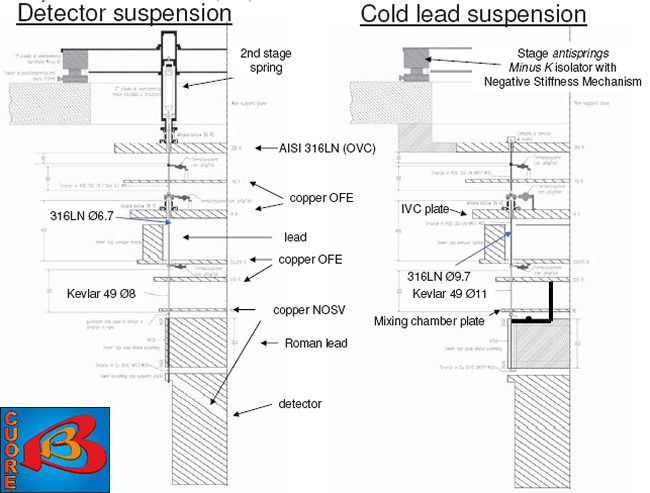
Minus K Technology works with many aerospace and education laboratories for custom vibration isolation systems. It offers a line of standard bench top, table and floor platform vibration isolation products. The company was founded in 1993 to develop, manufacture and market state-of-the-art vibration isolation products based on its patented negative-stiffness technology. Minus K® is based in the Los Angeles area.
For additional information, Contact Steve Varma, Operations Manager, Minus K Technology, 310-348-9656 or stevev@minusk.com
The press release can be found at: https://minusk.com/content/in-the-news/CUOREPress_0111.htm

News: Minus K Technology Is Veteran Owned and Certified California
Small Business
Minus K is a Veteran Owned Small Business.and
a certified State of California Small Business. All our products
are proudly made in the USA.


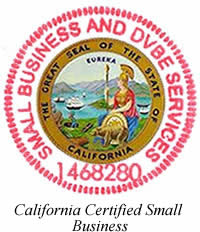

Comments/Suggestions: Applications in New Fields or Features of Interest to You in Our Next Newsletter:
Upcoming Meetings and Webinars:
 |
|
||||||||||||||||||||||||||||
This
ad is now on the Physics Today Online Buyer's Guide
<-------------------------------------------
Click
Here To Join Us Now On Facebook ![]()

We want to hear from you:
Tell us if you have had a great experience with our isolators.
Work with us on an article about how negative-stiffness has helped
you. Don't be shy. Share your application with our readers.
Do you have an application in a New Field? What applications are
of Interest to You?
Email us at newsletter@minusk.com

460 S. Hindry Ave., Unit C Inglewood, CA 90301
Tel: 310-348-9656 Fax: 310-348-9638
Contact Us www.MinusK.com
© Minus K Technology Inc., Vibration Isolation
Systems. All rights reserved.